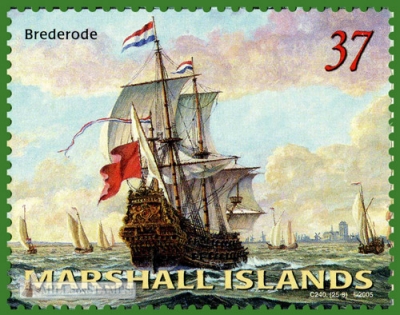-
2005-sheet-logo.jpg)

Number by catalogue: Yvert: 1914 Scott: 868h
Perforation type: 13 ½x13 ½
Subject:
37 cents. Dutch sailing vessel Brederode*.
On the right, on horizon it is possible to see some windmills (see a fragment below).Additional:
*Brederode was a ship of the line of the navy of the United Provinces of the Netherlands, and the flagship of the Dutch fleet in the First Anglo-Dutch War. Throughout its career, it carried from 53-59 guns.
She was named after Johan Wolfert van Brederode, the brother-in-law of stadtholder Frederick Henry, Prince of Orange. Launched at Rotterdam in 1644, and a design of shipwright Jan Salomonszoon van den Tempel, she was the flagship of Vice Admiral Witte Corneliszoon de With from May 1645 until 1647 when she was assigned to Lieutenant-Admiral Maarten Tromp. The same year however, she again became De With's flagship for his expedition to Dutch Brazil, only returning in 1650. Only in 1651 would Tromp sail for the first time with his flag on the Brederode, during an attack against royalist privateers operating from the Scilly Islands.
In the First Anglo-Dutch War Brederode was present under Tromp's command at the Battle of Goodwin Sands on 29 May 1652. After Tromp's failure to bring the English to battle off the Shetland Islands in July, Tromp was relieved and Michiel de Ruyter took over command. When De Ruyter was subordinated to De With in September, Brederode's crew refused to let the latter come on board to take command, so he had to content himself with the Prins Willem. Under De Ruyter, Brederode fought at the Battle of the Kentish Knock on 8 October 1652.
With Tromp back in command, Brederode fought at the Battle of Dungeness on 10 December 1652 where she came close to being captured, but was instrumental in that victory over the English. She fought again on 18 February 1653 at the Battle of Portland and on 12 June 1653 at the Battle of the Gabbard, where she fought an exhausting but inconclusive duel with William Penn's flagship James. On that day, the first day of the battle, Tromp's men boarded the English ship but were beaten back; boarded in turn by the English, Tromp was only able to dislodge the boarders by blowing up Brederode's deck. On 13 June the English were joined by a squadron under Admiral Robert Blake and the Dutch were scattered in defeat.
Brederode fought in the last major engagement of the war, the Battle of Scheveningen on 26 July 1653, when Tromp was killed. The acting flag captain (later Admiral) Egbert Bartholomeusz Kortenaer kept Tromp's standard raised after his death to keep up morale.
In the Northern Wars the United Provinces sent an expeditionary force to support Denmark in the war against Charles X of Sweden. In the Battle of the Sound on 8 November 1658 the Dutch fleet, commanded by Lieutenant-Admiral Jacob van Wassenaer Obdam, defeated a Swedish fleet and relieved the siege of Copenhagen. Van Wassenaer's flagship was Eendracht; De With commanded the van in Brederode; attacking the enemy without proper knowledge of the shoals he grounded his ship (after damaging Leoparden so much that this enemy vessel subsequently was lost by fire) and was surrounded; after many hours of fighting, Brederode was boarded by Wismar and De With mortally wounded. The partially burnt wreck was deemed unsalvagable._______

Bicentenary of Trafalgar Battle. Legendary fightin ships
Marshall Islands 2005.10.21
In issue: Stamp(s): 25 Souvenir sheet(s): 1 Sheet(s): 1
Printing: lithography
Issued in: sheets of 25 (5*5) stamps as one set